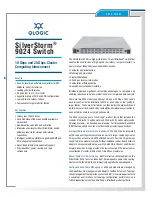
System-Defined RBAC User Roles
By default, the Dell Networking OS provides 4 system defined user roles. You can create up to 8 additional
user roles.
NOTE:
You cannot delete any system defined roles.
The system defined user roles are as follows:
• Network Operator (netoperator) - This user role has no privilege to modify any configuration on the
switch. You can access Exec mode (monitoring) to view the current configuration and status
information.
• Network Administrator (netadmin): This user role can configure, display, and debug the network
operations on the switch. You can access all of the commands that are available from the network
operator user role. This role does not have access to the commands that are available to the system
security administrator for cryptography operations, AAA, or the commands reserved solely for the
system administrator.
• Security Administrator (secadmin): This user role can control the security policy across the systems that
are within a domain or network topology. The security administrator commands include FIPS mode
enablement, password policies, inactivity timeouts, banner establishment, and cryptographic key
operations for secure access paths.
• System Administrator (sysadmin). This role has full access to all the commands in the system, exclusive
access to commands that manipulate the file system formatting, and access to the system shell. This
role can also create user IDs and user roles.
The following summarizes the modes that the predefined user roles can access.
Role Modes
netoperator
netadmin Exec Config Interface Router IP Route-map Protocol MAC
secadmin Exec Config Line
sysadmin Exec Config Interface Line Router IP Route-map Protocol MAC
User Roles
This section describes how to create a new user role and configure command permissions and contains the
following topics.
•
•
Modifying Command Permissions for Roles
•
Adding and Deleting Users from a Role
Creating a New User Role
Instead of using the system defined user roles, you can create a new user role that best matches your
organization. When you create a new user role, you can first inherit permissions from one of the system
Security
937
Содержание S4048T
Страница 1: ...Dell Configuration Guide for the S4048T ON System 9 10 0 1 ...
Страница 98: ... saveenv 7 Reload the system uBoot mode reset Management 98 ...
Страница 113: ...Total CFM Pkts 10303 CCM Pkts 0 LBM Pkts 0 LTM Pkts 3 LBR Pkts 0 LTR Pkts 0 802 1ag 113 ...
Страница 411: ...mode transit no disable Force10 Resilient Ring Protocol FRRP 411 ...
Страница 590: ...Figure 67 Inspecting the LAG Configuration Link Aggregation Control Protocol LACP 590 ...
Страница 591: ...Figure 68 Inspecting Configuration of LAG 10 on ALPHA Link Aggregation Control Protocol LACP 591 ...
Страница 594: ...Figure 70 Inspecting a LAG Port on BRAVO Using the show interface Command Link Aggregation Control Protocol LACP 594 ...
Страница 595: ...Figure 71 Inspecting LAG 10 Using the show interfaces port channel Command Link Aggregation Control Protocol LACP 595 ...
Страница 646: ...Figure 87 Configuring Interfaces for MSDP Multicast Source Discovery Protocol MSDP 646 ...
Страница 647: ...Figure 88 Configuring OSPF and BGP for MSDP Multicast Source Discovery Protocol MSDP 647 ...
Страница 648: ...Figure 89 Configuring PIM in Multiple Routing Domains Multicast Source Discovery Protocol MSDP 648 ...
Страница 653: ...Figure 91 MSDP Default Peer Scenario 2 Multicast Source Discovery Protocol MSDP 653 ...
Страница 654: ...Figure 92 MSDP Default Peer Scenario 3 Multicast Source Discovery Protocol MSDP 654 ...
Страница 955: ...Figure 119 Single and Double Tag First byte TPID Match Service Provider Bridging 955 ...
Страница 1179: ...Figure 147 Create Hypervisor Figure 148 Edit Hypervisor Figure 149 Create Transport Connector Virtual Extensible LAN VXLAN 1179 ...
















































